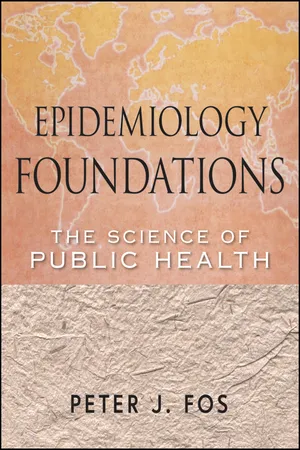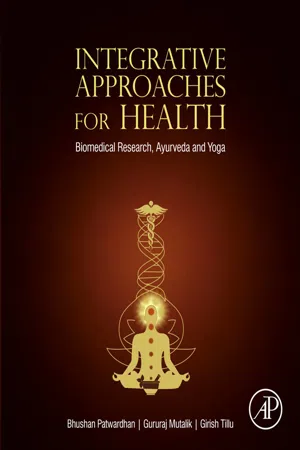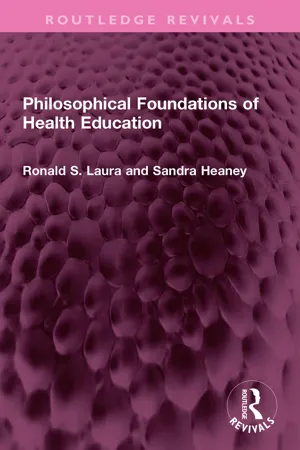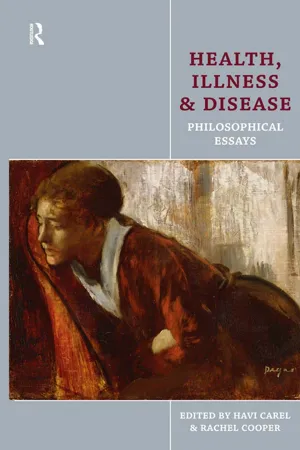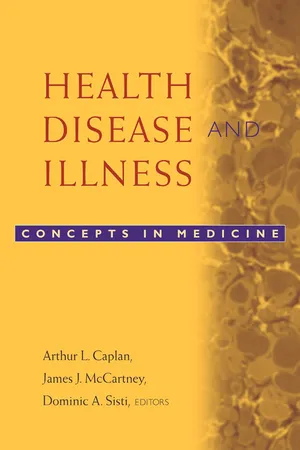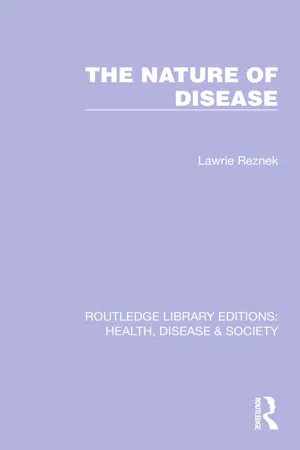Biological Sciences
Health and Disease
Health refers to a state of physical, mental, and social well-being, while disease is the opposite—a deviation from this state. In biological sciences, health and disease are studied in terms of their impact on the body's structure and function, as well as the underlying mechanisms that contribute to their development. Understanding these concepts is crucial for maintaining and improving overall well-being.
Written by Perlego with AI-assistance
Related key terms
10 Key excerpts on "Health and Disease"
- eBook - ePub
Epidemiology Foundations
The Science of Public Health
- Peter J. Fos(Author)
- 2010(Publication Date)
- Jossey-Bass(Publisher)
CHAPTER 3 Health and DiseaseLEARNING OBJECTIVES On completing this chapter, you will be able toDiscuss what is meant by health Discuss what is meant by disease Describe the distinction between Health and Disease Describe the natural history of disease Discuss the general concept of causal relationshipsDefinitions 36 Distinction Between Health and Disease 37 Disease Progression 39 Cause and Effect 43 Summary 49DefinitionsHealth is something that seems easy to identify and measure. We can take our temperature to see if we have a fever. We can get blood tests to determine disease. But what about quality of life? How is it measured? In this chapter, we will discuss what is meant by health and the notion of health-related quality of life. Should more attention be given to how Health and Disease affect our everyday life, and not on measuring health test results? In this chapter, we will explore this question, but first, let’s define Health and Disease.HealthThe World Health Organization defines health as a state of complete physical, mental, and social well-being and not merely the absence of disease or infirmity.1 This definition was ratified during the first World Health Assembly and has not been changed since 1948. In 2000 Pope John Paul II offered a more comprehensive definition of health as “A dynamic tension towards physical, mental, social, and spiritual harmony, and not only the absence of illness, which gives man the ability to fulfill the mission which has been entrusted to him.”2Health has two aspects that influence it. The first is physical health, which is often referred to as physical fitness. Physical health is dependent on proper nutrition, exercise, and other healthy life behaviors. The other aspect of health is mental health. Mental health is defined as “A state of emotional and psychological well-being in which an individual is able to use his or her cognitive and emotional capabilities, function in society, and meet the ordinary demands of everyday life” (Merriam-Webster Online Dictionary, http://www.merriam-webster.com/dictionary/mentalhealth - eBook - ePub
Integrative Approaches for Health
Biomedical Research, Ayurveda and Yoga
- Bhushan Patwardhan, Gururaj Mutalik, Girish Tillu(Authors)
- 2015(Publication Date)
- Academic Press(Publisher)
[9] . This terminology illustrates that we do understand the real causes of many diseases, and we prefer to classify them into the ready-made categories, which perhaps do not accurately reflect the nature of the disorder, disease, or condition. Many new diseases are the result of the failure of current drug treatments, or of socioeconomic and environmental changes. For instance, drug-induced diabetes is actually not a disease, rather, it is a condition created by therapeutic interventions. Thus, the concept of disease has changed during last few decades.Definition of Health
The WHO defines health as “a state of complete physical, mental and social well-being and not merely the absence of disease or infirmity” [10] . However, in practice, there is no robust and reliable way to measure well-being . Generally, the absence of disease or infirmity is considered to be health . In many quarters, the terms health and medicine are used interchangeably, without an appreciation of the difference in meaning of the two words. Today’s health care revolves predominantly around medicine—primarily dealing with disease diagnosis and treatments, and not as much on prevention and health promotion. This mind-set has its roots in the misunderstanding of health.Many experts feel that the WHO definition of health is not complete without the inclusion of the spirituality component. The WHO definition highlights something like well-being that is difficult to measure, and hence health care decisions are being made based upon the apparent absence of disease. Moreover, modern definitions of health are mostly restricted to the body, and to some extent, the mind. However, the holistic picture of body/mind/spirit is completely missing in modern descriptions of health. The WHO have been discussing the concept of spiritual health, and several recent studies have endorsed its importance. In 1997, the WHO’s executive board resolved to recommend to the General Assembly of the United Nations, a new definition of health: “Health is a dynamic state of complete physical, mental, spiritual and social well-being and not merely the absence of disease or infirmity.” A WHO’s spokesperson stated that “if we can find ways to approach practically the spiritual dimension of health, we may be able to alleviate and combat some of the pressures of modern life.” - eBook - ePub
- Ronald S. Laura, Sandra Heaney(Authors)
- 2022(Publication Date)
- Routledge India(Publisher)
Meditation has been shown to be a beneficial strategy for the management of a number of clinical and health-related problems. Its efficacy in comparison to other self-regulating strategies for stress management is encouraging, but more research needs to be done in this area to clarify ambiguities in the analysis of its clinical effectiveness. That meditation works to reduce stress by enhancing the relaxed state indicates that the reconceptualization and reorganization of our patterns of lifestyle which make us tense and unrelaxed must also be addressed. The potentially oppressive restrictions of the clock can undermine our health as assuredly as can the traumas of life. Ultimately, health will depend upon the capacity of an organism to adapt constructively to environmental stressors on the one hand, and upon the capacity of the community and society to ensure that the stressors which we cannot avoid and which are of our own making do not dissipate the human organism beyond the point of its potential for compensatory restoration and growth on the other.Summary
In the present chapter we have considered the traditional definitions of Health and Disease and have found them deficient on several counts. We observed that inasmuch as modern medical science adheres to a limited view of biology which is quantitative and reductionistically oriented, the concept of health as the absence of disease unsurprisingly reflects the impoverished philosophy of medical scientism which underpins it. The growing commitment to holistic health signals a salutary corrective to the myopia of modern medical scientism.In the light of the philosophical framework of the previous chapter we considered the relevance of the systems view of life as providing an alternative and holistic perspective on health. We saw that on the systems view, self-organizing systems are characterized by hierarchical levels and a fundamental interdependency among them. Rather than being regarded as a monolithic relation between signs and symptoms on the one hand and micro-organisms on the other, disease is construed on the systems model as a failure of adaption to an environmental challenge which in consequence causes disruption to the integrity of the living system. Patterns of disruption cannot be confined to a particular level of organizational complexity, as what impinges on one level in turn impacts upon the others. Ultimately, health is a global matter. - eBook - ePub
The Energetics of Health
A Naturopathic Assessment
- Iva Lloyd(Author)
- 2009(Publication Date)
- Churchill Livingstone(Publisher)
Section II Theories, Patterns and Definitions of Health and DiseasePassage contains an image
Chapter 4 Human beings as complex, dynamic systems of energyWaves of light energy 60Cellular communication 63The role of water 65Movement 66Complex systems 66Self-organizing 69Open systems 70Self-renewal 70Mutual causality 71Self-transcendence 72References 72Further reading 73Historically, much of the conventional medical research and meaning of health was determined by what the physical body was doing on a chemical and structural level. There was the recognition that thoughts and language play a role in disease, but the interpretation, all too often, started and ended with cellular processes. Human beings were viewed using mechanistic and dualistic concepts; they were treated as separate from their external environment, and the mind was viewed as separate from the body.These old beliefs were challenged for years as there were many unanswered questions. For example, the speed of communication could not be explained by the key and lock analogy that was used to explain communication across cellular membranes. There was no clear explanation of how the body was able to handle multiple tasks simultaneously, how language, thoughts, and emotions elicited specific physiological changes, or how the environment or social factors impacted health. There was also little knowledge of how memory was stored or retrieved or what initiated or controlled functions such as growth, development, or longevity (McTaggart 2002 ).The perception and understanding of how human beings function and survive has been broadened and continues to expand based on new discoveries. Systems theory supports the concepts of vitalism and holism and provides a framework for explaining the complexity and dynamic interconnectedness of all aspects of life (Capra 1996 ). The discovery that electrical fields of energy are the foundation of life provides increased knowledge about cellular communication and how endogenous and exogenous factors affect health (McTaggart 2002 - eBook - ePub
- Anna T. Crouch, Clency Meurier, Anna T. Crouch, Clency Meurier(Authors)
- 2015(Publication Date)
- Wiley-Blackwell(Publisher)
To make some sense of the various interpretations of health, Blaxter (1990) has put forward the notion that definitions of health may be categorised as negative or positive. From this perspective, descriptions of health such as not experiencing signs and symptoms of disease (i.e. not having a swelling and pain) or simply being free of disease and disability (i.e. not having been diagnosed as having a disorder) will fall into the category of negative definitions of health. On the other hand, positive definitions of health will include statements linking health to feeling physically fit or, more generally, a condition of psychological and social well-being will be interpreted as positive (e.g. feeling able to cope with life).In the Western world, the ‘absence of disease’ concept has been the most enduring and widely accepted view of health. It is considered as ‘negative’ because it focuses on an ‘absence’ of ill health rather than on the positive state. One is either healthy or has a disease; there is no in-between. Within this framework, health is considered as the direct opposite to disease. In this sense, it is a polarised view of health. Even if one feels unwell due to a disease process, one may be denied sympathy and may not be able to adopt the ‘sick role’ (Parsons, 1975) until such time as the disease has been formally diagnosed by the doctor. Conversely, people with chronic conditions and disabilities may be labelled as ‘sick’, although they themselves may otherwise feel healthy.The ‘absence of disease’ definition of health is linked to what is called the ‘medical model’, in which disease is viewed as a pathological state or deviations of biological functions. Many people have embraced this view of health because of its apparent simplicity and the dominance of the medical view of health in Western societies. This view of health may sometimes have its benefits as people may at least regard themselves as healthy if they do not suffer from any diagnosed disease. Minor ailments can also be brushed aside because they may not be considered as ‘real’ disease. - eBook - ePub
Health, Illness and Disease
Philosophical Essays
- Havi Carel, Rachel Cooper(Authors)
- 2014(Publication Date)
- Routledge(Publisher)
1Let me make three brief comments on these latter definitions. First, observe that the criterion of health is compound in the following sense. Health is not identical with a certain kind of ability. The criterion says: A is in a bodily and mental state which is such that A has an ability to realize vital goals. For instance, A’s physiological condition is adequate and A is feeling well, and thus A is able to realize his or her vital goals. Second, “vital goal” is a technical concept in the sense that people’s vital goals are not completely identical with their intentionally chosen goals. The class of a person’s vital goals is the class of conditions that are such that the fulfilment of them is necessary for the person’s long term minimal happiness. Thus all people, including babies, persons with dementia and others who do not consciously set any goals in life, have vital goals. Third, the phrase “tends to reduce the health of A” is selected because not all diseases actually do compromise health in the holistic sense of being able to realize vital goals. Some diseases are aborted; that is, they disappear before they have influenced the person as a whole. Others are latent; yet others are so trivial that they are never recognized by their bearer (for comprehensive discussions of all these conditions, see Nordenfelt 1987 /1995 and, in particular, 2001).The presented versions of the BST and the HTH are clearly quite different theories of health. The differences can be summarized thus:- In the BST health is exclusively a function of internal processes in the human body or mind and their relation to reproduction and survival. In the HTH health is a function of a person’s abilities to perform intentional actions and achieve goals.
- In the BST health is a concept to be defined solely in biological (or perhaps also psychological) and statistical terms. In the HTH the concept of health presupposes extra-biological concepts such as “person’, ”intentional action“ and ”cultural standard’!
- eBook - ePub
Health, Disease, and Illness
Concepts in Medicine
- Arthur L. Caplan, James J. McCartney, Dominic A. Sisti(Authors)
- 2004(Publication Date)
- Georgetown University Press(Publisher)
serious disease with incapacitating effects that make it undesirable. A shaving cut or mild athlete’s foot cannot be called an illness, nor could one call in sick on the basis of a single dental cavity, though all these conditions are diseases. Secondly, to call a disease an illness is to view its owner as deserving special treatment and diminished moral accountability. These requirements of “illness” will be discussed in some detail shortly, with particular attention to “mental illness.” But they explain at once why the notion of illness does not apply to plants and animals. Where we do not make the appropriate normative judgments or activate the social institutions, no amount of disease will lead us to use the term “ill.” Even if the laboratory fruit flies fly in listless circles and expire at our feet, we do not say they succumbed to an illness, and for roughly the same reasons as we decline to give them a proper funeral.There are, then, two senses of “health.” In one sense it is a theoretical notion, the opposite of “disease.” In another sense it is a practical or mixed ethical notion, the opposite of “illness.”11 Let us now examine the relation between these two concepts more closely.DISEASE AND ILLNESS
What is the theoretical notion of a disease? An admirable explanation of clinical normality was given thirty years ago by C. Daly King.The normal… is objectively, and properly, to be defined as that which functions in accordance with its design?12The root idea of this account is that the normal is the natural. The state of an organism is theoretically healthy, i.e., free of disease, insofar as its mode of functioning conforms to the natural design of that kind of organism. Philosophers have, of course, grown repugnant to the idea of natural design since its cooptation by natural-purpose ethics and the so-called argument from design. It is undeniable that the term “natural” is often given an evaluative force. Shakespeare as well as Roman Catholicism is full of such usages, and they survive as well in the strictures of state legislatures against “unnatural acts.” But it is no part of biological theory to assume that what is natural is desirable, still less the product of divine artifice. Contemporary biology employs a version of the idea of natural design that seems ideal for the analysis of health. The crucial element in the idea of a biological design is the notion of a natural function. I have argued elsewhere that a function in the biologist’s sense is nothing but a standard causal contribution to a goal actually pursued by the organism.13 - eBook - ePub
Social Ecology in the Digital Age
Solving Complex Problems in a Globalized World
- Daniel Stokols(Author)
- 2018(Publication Date)
- Academic Press(Publisher)
Social ecological analyses of health and illness build on and extend the biomedical and biopsychosocial paradigms by considering not only biological, psychological, and sociocultural determinants of well-being but also environmental factors in health such as pollution, radiation, and safety hazards in vehicles, workplaces and homes; urban stressors such as overcrowding, traffic congestion, and noise; online bullying, stalking, and identity theft; and global climate change.This chapter offers a social ecological perspective on health and illness. The shift toward a social ecological paradigm coincided with key developments in medicine and public health. The 1979 US Surgeon General’s Report alerted the American public to the harmful effects of unhealthy behaviors—especially smoking and substance abuse—on personal and community well-being [11] . As evidence for the links between tobacco use, lung cancer, and heart disease grew during the 1970s and 1980s, the predominant emphasis on medical treatment of disease was supplemented by preventive strategies to reduce high-risk behaviors and promote healthier lifestyles [9 ,10 ,12 ,13 ]. The prevailing view of health as merely the “absence of illness” was supplanted by broader conceptions of wellness defined as “complete physical, emotional, and social well-being” [14 –16 ].At the same time, person-focused models of medical treatment and disease prevention expanded to include environmental enhancement, organizational and community initiatives, and regulatory approaches to improving population health [17 –22 ]. The “new public health” outlined in the Ottawa Charter identified sociocultural and physical environmental causes of illness above and beyond biological aspects of disease [15 ,23 ], spawning new research on the benefits of health-promotive environments for individuals and populations [24] . These new perspectives gave rise to social ecological models [25 –27 ] that combine biological, behavioral, sociocultural, and environmental influences on health and include multiple measures of physical, emotional, and social well-being at individual and community levels [28] . In addition to considering the joint impact of many factors on health (e.g., microscopic pathogens, psychosocial stressors, physical safety hazards, cybercrimes), social ecological models address several criteria of well-being including mental health, physiological risk factors, and illness symptoms for acute/infectious and chronic/noninfectious diseases; as well as intentional and unintentional injuries (e.g., suicides and homicides, vehicle crashes, sports injuries) and social integration at community levels [28 –30 - eBook - ePub
Educating Doctors
Crisis in Medical Education, Research and Practice
- Stewart Wolf(Author)
- 2018(Publication Date)
- Routledge(Publisher)
6Determinants of Health and Disease
Searching for a Cause
The traditional line of inquiry in the study of disease has been to seek ultimate causes. In the sixteenth century, Jean Fernel wrote, “Misbalance of the Constitution is the illness, yet the cause is the practical point. There are causes we do not know” (Sherrington, 1946). The concept of “cause” has undergone radical change from era to era in medicine until today the search for a single cause has been all but abandoned. In its place we have the currently popular concept of multicausality of diseases, something resembling Fernel’s “misbalance.” It recognizes that the number of ways things can go wrong is less than the number of things that can perturb the bodily economy. It also takes into account the myriad regulatory mechanisms of the body, disruptions of which are manifested as diseases (Wolf, 1963).While microbes and toxins are numbered among the agents of disease, in most instances it is the body’s response that constitutes the manifestations of disease, as vividly demonstrated by Rowe, who irradiated mice to impair their lymphocyte response to injection of the virus of lymphocytic chloriomenengitis. Without preliminary radiation, all animals sickened and nearly all died. The irradiated animals, on the other hand, were actually protected against any evidence of illness but, nevertheless, they continued to harbor the virus (Rowe, 1956). There are many other examples showing that infectious diseases represent not so much the depredations of the invader as they do the adaptations of the host: the tubercle in tuberculosis, for example, and the precipitated antigen-antibody complex in the glomerular tuft in Bright’s disease are the product of the defensive behavior of the body.Since the variety of possible adaptations is limited, the same types of molecular and cellular reactions show up in various parts of the body as pathogenic mechanisms or conditions that we designate as separate diseases. Today more attention is paid to the disturbed regulatory processes than to the naming of diseases. Such regulatory disturbances responsible for the manifestations of various diseases can be triggered or augmented, or perhaps inhibited by a variety of external forces, by individual behaviors, and even by the way a person interprets or deals with his human relationships and life experiences. - eBook - ePub
- Lawrie Reznek(Author)
- 2022(Publication Date)
- Routledge(Publisher)
If diseases do not share a particular real essence in virtue of which they are all diseases, it is natural to ask whether diseases have a nominal essence. All diseases do seem to share some properties - all diseases are processes - they have an onset, a typical course, and an outcome. This is in contradistinction to certain of the other negative medical conditions like defects, deformities, disabilities, lesions, and injuries. If part of the nominal essence of disease is that diseases are processes that can evolve, this would explain just why it is that these other negative medical conditions are not classified as diseases. For these terms refer to static states of the body rather than processes. As Downie and Telfer put it:But it should be noticed that deformity, unlike illness and disease, is not as such incompatible with good health. Of course there are some deformities, such as ‘a hole in the heart’ which produces mechanical failures like those of illness, and a sufferer from these is said to be in poor health, as we say earlier. But a ‘thalidomide baby’ who has only vestigial limbs can still be described as healthy. Similarly, a child who is born with a malformation of the ears which makes him deaf is not called unhealthy. It is true that a person who is severely handicapped in this way might hesitate before stating on a form that he is in good health, but broadly speaking these handicaps, severe though they are, are somehow not thought of as impairing health. ... The explanation seems to be that illness and disease are seen as things which essentially progress or change in a law-like manner, which have a life of their own. ... In such cases one can always sensibly ask whether the sufferer is getting better or worse. Being ill is essentially an unstable situation. The thalidomide victim, by contrast, is fixed in his disability, and so he is not regarded as unhealthy because there is nothing untoward going on in him (Downie and Telfer, 1980 , p.20).What is being suggested here is that if some condition is not a process, it is not a disease. Caroline Whitbeck agrees: ‘Diseases, unlike injuries and impairments, are processes’ (Whitbeck, 1978 , p.210). Injuries might undergo changes - most injuries undergo a process of healing. But the fact that a skull fracture can be healed (and so have a natural history) does not mean that a skull fracture is
Index pages curate the most relevant extracts from our library of academic textbooks. They’ve been created using an in-house natural language model (NLM), each adding context and meaning to key research topics.
